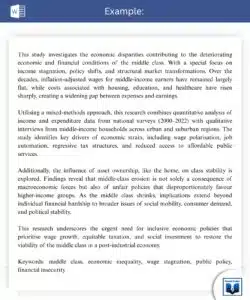An abstract of a dissertation is usually a concise summary of around 2.5-5% of the whole word count. Briefly presenting the research aims or methodology, key findings, and conclusion of the research study. It helps readers understand the core ideas and significance of the dissertation/thesis.
Dissertation Abstract Example
Here is an abstract example of an economics dissertation to help you get started, strictly written according to the dissertation writing guide.
What is the Length of a Dissertation Abstract?
An abstract of a dissertation/thesis should be around 2.5-5% of the whole word count (depending on the requirements) of your institution. It should be a precise summary from the objectives to the conclusion of the study.
What is the Difference Between an Abstract and an Introduction?
Here is a concise table explaining the difference:
| Abstract | Introduction |
|---|---|
| Summarises the whole study. | Introduces the topic, background, and research objectives. |
| Usually 2.5-5% of the whole dissertation. | Usually around 7-15% of the whole study. |
| Positioned before the table of contents. | Positioned as Chapter 1 or Section 1. |
| Briefly mentions key results and findings. | Only contains research questions or hypotheses. |
| Includes keywords at the end. | No mention of key terms or phrases. |
Can You Use Thesis Content in an Abstract?
No, you can’t use the already written content of your research paper or thesis for abstract writing. It should be an entirely autonomous and independent text and never be an exact excerpt taken from within the paper’s original content. This also implies, indirectly, that it is unethical in research to copy-paste chunks from within your own study in an abstract.
Looking for dissertation help?
Research Prospect to the rescue then!
We have expert writers on our team who are skilled at helping students with dissertations across a variety of disciplines. Guaranteeing 100% satisfaction!
Here, we have put together some guidelines for students to understand how to write an abstract for a dissertation to make a great first impression on readers.
Common Abstract Writing Mistakes & Solutions
| Mistakes | Solutions |
|---|---|
| Created with Sketch Beta. Adding everything seemingly important to the content. | Only add results that are directly relevant to your research questions or objectives. |
| Created with Sketch Beta. Narrating the whole methodology from top to bottom. | Briefly state your technique of data collection and results finding. |
| Created with Sketch Beta. Starting with generic statements | Use problem-solution oriented, surprising statistics, or compelling contradictions. |
| Created with Sketch Beta. Missing adding solutions about the highlighted problems. | Connect practical applications or theoretical contributions to present a holistic explanation. |
| Created with Sketch Beta. Using inconsistent tenses throughout the abstract. | Use the past tense for completed research, present tense for conclusion, and implications. |
Key Components of a Dissertation Abstract
Here are the key elements of a dissertation abstract that you need to consider while writing.
- Background statement/problem statement/thesis statement
- Information regarding the research sample
- Research methodology employed
- A brief description of the results obtained and their interpretation (only the most important one(s))
- A summary of the conclusion, limitations, and future recommendations/implications (only the most salient ones)
1. Background/Problem Statement/Aims and Objectives
The first couple of sentences of your dissertation abstract should provide a summary of the purpose of your research. This can be expressed as follows:
- Background statement – Provide a brief perspective on the theoretical and practical significance of your work.
- The problem statement clearly communicates to the readers why there was a need to research the chosen topic.
- Present an overview of the research’s aim and objectives to establish what your research intends to achieve.
- Thesis statement – what is the main idea of your dissertation paper? What are your claims in reference to the established research questions?
Avoid writing this part of the abstract in the future tense because it refers to concluded actions.
- This study will investigate the relationship between a healthy diet and fitness.
- This study investigates the relationship between a healthy diet and fitness.
Also read: How to Get Dissertation Deadline Extension – Some Practical Methods.
2. Sample or Source of Data Collection
This one-to-two-lined section will give information about who the sample in your study was; where they are located/residing, etc. The reasons for selecting that group of participants, for instance, are not relevant to mention in an abstract.
3. Research Methods
Briefly specify your dissertation research methodology immediately after stating the purpose and sample of your dissertation paper. Here, you will be expected to summarise how you straightforwardly conducted your research.
Like the first section, a description of research methods should also be written in the simple past tense. There is absolutely no need to highlight the limitations and/or validity of your research methods here.
The goal is to take the readers through the overall approach and process quickly.
4. Research Finding
Provide a brief overview of the major findings of your dissertation study. If you think you have undiscovered multiple major findings, only mention the ones that directly answer a research question or two that was/were part of your study to begin with.
For instance, if you studied the relation between two variables and your findings indicate it’s a positive correlation, you simply state that finding, not the other minor ones related to this specific one.
This section is the crux of your abstract, so make sure you demonstrate how your research addressed the research objectives.
Furtrermore, due to the general word limit (150-200) (check your university or journal requirements for clarity) of the abstract and the complexity of your research, you might not be able to include all results here. If that is the case, have only the most significant results.
This portion should be written in the past simple or present tense. Here is an example:
- Analysis of the responses has shown that there is a strong correlation between a healthy diet and fitness.
- Analysis of the responses shows there is a strong correlation between a healthy diet and fitness.
- Analysis of the responses showed there was a strong correlation between a healthy diet and fitness.
5. Conclusion and Recommendations/Implications
Lastly, the abstract of a dissertation should conclude your dissertation research. The conclusion should clearly report how your study addressed the research problem.
Use this part of the abstract to convince people how your research proved the argument or theory your research was built on and started off with.
Provide recommendations for practical implementation to clearly understand your audience and how your work will solve the problem at hand.
Finally, do not forget to mention important research limitations briefly. For example, selecting a smaller sample size due to some constraints would be a limitation worth mentioning. This will add more weight and credibility to your research.
Make use of the present simple tense when writing the conclusion.
Some institutions, however, dictate that you write one or two lines about the long- or short-term implications your research might have. This component would be the last one in an abstract, preceded by the conclusive statement.
What are Abstract keywords/Phrases?
These are key terms and phrases that you need to add at the end of the abstract. Before submitting the study to your university and the paper for publication in an academic journal..
For example, if your study is about how cybersecurity is shaping the future of academic research. Then, simply add relevant terms or phrases your study is all about at the end of the abstract. Like, cybersecurity in academia, risks associated with AI in writing, ethics of AI surveillance, cyberbiosecurity in labs, etc.
You need to add keywords in your dissertations or papers to improve their searchability and visibility in academic databases and search engines. It increases the chances of your study being discovered by other researchers working on the same topic or ideas that you have discussed.
Students often search key phrases online to find relevant studies and add references in their literature reviews. Adding the right terms will increase your chances of becoming a cited researcher.
Abstract According to Different Style Guides
The key rules are as follows:
MLA
Researchers are required to add the abstract section right after the title page and before the table of contents of your dissertation or paper. No heading is required; you can add one if your university instructs, and the whole content needs to be in Times New Roman 12pt, double-spaced.
APA
As a rule of thumb, the abstract should appear after the title page, and according to APA style, it should be positioned on a new page. The heading should be placed in the center and at the top in bold, Abstract.
Content should be in Times New Roman, 12pt, double-spaced, and lastly, add keywords in italics at the end of the content.
Harvard
Like MLA and APA style of formatting, the abstract should be after the title page, and the heading should be centered or bolded. However, the content must be in Times New Roman or Arial, 12pt, with 1.5 or double spacing. You also need to mention key phrases at the end to comply with the Harvard style of formatting.
Checklist to Ensure Perfect Abstract Writing for Dissertation
- Verify that the word count added is according to the requirements.
- Ensure the brief does not exceed a single page, as most institutions require only one page.
- Is the abstract appearing before the title page, acknowledgements, and table of contents?
- The research problem and objectives are followed by the methodology.
- Every element from the research question to the findings is covered?
- Check that important limitations and recommendations are clearly mentioned.
- The abstract is easy to understand without prior knowledge of the topic or not.
6 Tips on How to Write the Abstract for a Dissertation
- Avoid citing publications or even quotes in the abstract.
- Be concise and to-the-point, avoid adding vague verbiage.
- Read sample abstracts of experts to understand the mantra.
- Don’t divide the abstract into paragraphs and keep it on a single page.
- Use simple language and add key terms throughout the content.
- After writing the draft, remove the extra content to keep the length short.
Common Mistakes to Avoid While Writing an Abstract
To help you craft a perfect abstract for your thesis or research paper, we have outlined some common mistakes to avoid..
| Common Mistakes ❎ | Recommended Solutions ✅ |
|---|---|
| Including all seemingly important content without focus | Focus only on results directly relevant to your research questions/objectives |
| Detailed narration of entire methodology | Briefly summarize data collection techniques and key findings |
| Beginning with generic, non-specific statements | Start with problem-solution approach, surprising data, or thought-provoking contradictions |
| Presenting problems without proposed solutions | Connect findings to practical applications or theoretical contributions |
| Inconsistent verb tense usage | Use past tense for completed research, present tense for conclusions and implications |
Frequently Asked Questions
No, you should not. It is important for an abstract to be an entirely autonomous and independent text and never be an extract taken from within the paper’s original content. Write it in your own words,
The abstract of your dissertation provides a brief overview of the research conducted and the results obtained.
The abstract of your dissertation must give background information, mention the problem statement, research aims, and objectives, sample information, methods of research, the findings, conclusion and recommendations/implications.
No, you must never cite any reference in the abstract.








